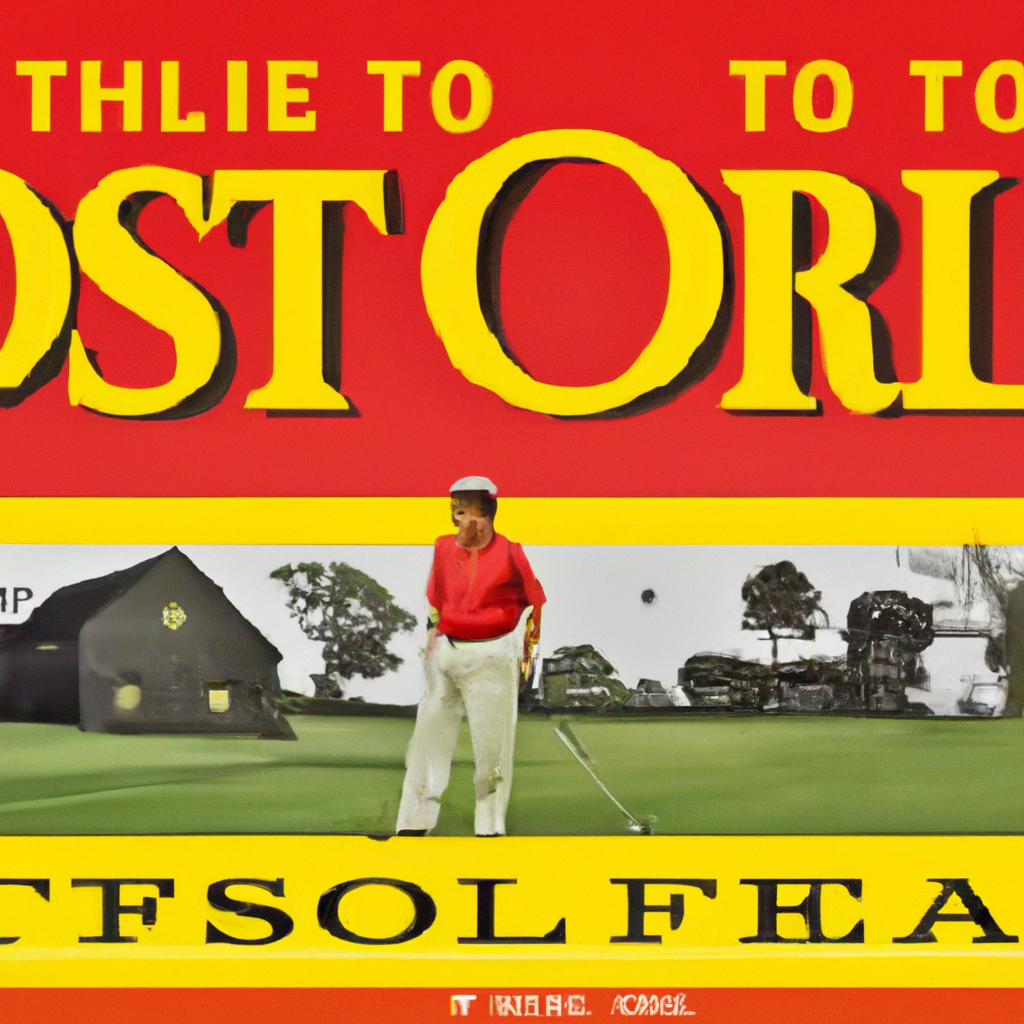Imagine yourself transported back in time to the rolling green hills of Scotland, where the age-old sport of golf originated. A fascinating journey awaits as we uncover the origins of this beloved game, tracing its roots to a time when kings and commoners alike discovered a passion for swinging a club and chasing after a small, white ball. From its humble beginnings in the 15th century to its prestigious status as a global phenomenon today, the story of golf’s creation is one that will captivate and inspire. So, grab your clubs and join us as we delve into the intriguing history of the game that has stood the test of time.

Ancient Origins
Ancient Stick and Ball Games
The history of golf can be traced back to ancient times when stick and ball games were a popular activity across various civilizations. These early games laid the foundation for the sport we know today as golf. Many ancient cultures, including the Egyptians, Greeks, and Romans, had their own versions of stick and ball games that shared similarities with golf. Although the precise origins of golf remain unclear, it is believed that these early games influenced the development of the sport.
Roman Games
During the Roman period, a game called “Paganica” gained popularity. Paganica involved using a bent stick to hit a stuffed leather ball towards a predetermined target. Players would take turns hitting the ball until it landed in the designated area. This ancient Roman game bears striking resemblances to modern-day golf, as it required skilled ball-striking and precision. It is possible that Paganica served as an early inspiration for the sport of golf.
Chinese Chuiwan Game
In China, a similar game known as “Chuiwan” emerged during the Tang Dynasty (618-907 AD). Chuiwan, which translates to “striking the ball,” was played with a curved club and a ball made of leather. Players would aim to strike the ball into a series of designated targets within a specified number of strokes. Chuiwan was popular among both the nobility and commoners, and it became a significant part of Chinese culture. This ancient Chinese game laid the groundwork for the development of golf in Asia.
Medieval Beginnings
Early Games in Scotland
While the ancient stick and ball games influenced the birth of golf, it was in Scotland where the sport truly took shape. The Scottish people embraced the game and played various versions of it throughout the Middle Ages. These early Scottish games included “gowf” or “gowff,” which involved hitting a pebble with a primitive club, often in a coastal area. The rugged Scottish terrain and natural landscapes provided the perfect setting for these early golf-like games.
St. Andrews Links
One of the most significant locations in the history of golf is the St. Andrews Links in Scotland. This renowned golf course is considered to be the oldest in the world, dating back to at least the 15th century. St. Andrews became a hub for golfing enthusiasts, with people from all walks of life coming to play the game. The popularity of golf at St. Andrews contributed significantly to the spread and development of the sport throughout Scotland and beyond.
The Oldest Written Record
The earliest written record that specifically mentions golf can be found in the Scottish Parliament’s records in 1457. The document, known as the “Act Against Football and Golfe,” prohibited both these sports, emphasizing the need for archery practice instead. This decree suggests that golf was already a widely popular game by this time, prompting concerns about its possible interference with important military training.
Evolution of Golf Equipment
Early Golf Balls
In the early days of golf, various materials were used to create balls. Initially, wooden balls carved from hardwood were used, but these often proved to be too heavy and impractical. The search for more suitable materials led to the introduction of balls made from stitched leather.
Feathery Balls
The next major advancement in golf ball technology came in the 17th century with the creation of the “feathery” ball. These balls were made by stuffing a leather pouch with boiled feathers and stitching it together. The feathery balls had better flight characteristics and were more durable compared to their wooden counterparts.
Gutty Balls
In the mid-19th century, a groundbreaking innovation occurred with the invention of the “gutty” ball. These balls were made from a solid rubber-like substance called gutta-percha. The gutty ball revolutionized the game, offering improved distance and control. Golfers quickly embraced this new technology, and it served as a catalyst for the sport’s popularity.
Hickory Shaft Clubs
Golf clubs also underwent significant changes with the advent of new materials. Hickory wood became the preferred choice for club shafts due to its strength and flexibility. The introduction of hickory shaft clubs allowed for more powerful swings and enhanced accuracy.
Advancements in Club Design
With the advancement of technology, club design continued to evolve. In the late 19th and early 20th centuries, golfers began experimenting with different clubhead shapes and materials. Steel clubheads replaced the traditional wooden ones, providing increased durability and improved performance. This development marked a significant leap forward in club design and set the stage for further advancements in the modern era.
Creation of the Rules
The Honourable Company of Edinburgh Golfers
In 1744, the Honourable Company of Edinburgh Golfers (HCEG) was formed and is now recognized as the oldest golf club in the world. The HCEG played a pivotal role in the establishment of standardized rules for the game.
The First Rules of Golf
The first known set of written rules for golf were introduced by the HCEG in 1744. These rules, also known as the “Articles and Laws in Playing at Golf,” provided guidelines for various aspects of the game, including the size of the hole, equipment regulations, and proper conduct on the golf course. Many of these early rules laid the foundation for the rules that govern the game today.
Formation of the Royal and Ancient Golf Club
In 1754, the Royal and Ancient Golf Club of St. Andrews was formed. This esteemed club played a significant role in the development and codification of the rules of golf. The Royal and Ancient Golf Club became the governing body for the sport and continued to evolve and refine the rules over the years. Today, it is known as The R&A and, along with the United States Golf Association (USGA), is responsible for setting the rules of golf worldwide.
Spread of Golf
Golf in England and Ireland
After its establishment in Scotland, golf began to spread to other parts of Great Britain. England and Ireland saw the emergence of numerous golf clubs in the late 18th and early 19th centuries. The Royal Blackheath Golf Club, established in 1766 in southeast London, is recognized as the oldest golf club in England. In Ireland, the Royal Belfast Golf Club, founded in 1881, played a pivotal role in popularizing the game across the country.
Golf in the United States
Golf found its way to the United States in the late 18th century. The game gained significant traction in the 19th century, particularly in the Northeast region. The Saint Andrew’s Golf Club in New York, founded in 1888, became the first official golf club in the United States. Golf continued to grow in popularity, and the sport’s presence spread across the country, eventually leading to the establishment of the United States Golf Association (USGA) in 1894.
Golf in Canada
Canada’s introduction to golf can be traced back to the early 19th century when Scottish immigrants brought the sport with them. The Royal Montreal Golf Club, founded in 1873, became the first organized golf club in North America. Golf quickly spread throughout Canada, with numerous clubs being established across the country. Today, Canada boasts a vibrant golfing community and is home to several prestigious golf courses.
Golf in Australia
The origins of golf in Australia can be traced back to the early 19th century. Scottish immigrants and British colonial officials introduced the game to the continent. Several golf clubs were established in the late 19th century, with the Royal Melbourne Golf Club, founded in 1891, being one of the most notable. Golf gained popularity in Australia, and the country has produced numerous talented golfers who have achieved success on the international stage.
Golf in Asia
In the late 19th and early 20th centuries, golf started to gain a foothold in various Asian countries. British colonial influences played a significant role in the spread of the sport. India, in particular, saw the establishment of several golf clubs during the colonial era. Japan also embraced golf during this time, eventually becoming one of the leading golfing nations in Asia. Today, golf has become increasingly popular across Asia, with countries such as South Korea and China producing world-class golfers.
The Birth of Golf Championships
The Open Championship
The Open Championship, often referred to as The British Open, is the oldest golf championship in the world. It was first played in 1860 at Prestwick Golf Club in Scotland and has since become one of the most prestigious tournaments in golf. The Open Championship continues to attract the best players from around the globe, showcasing the rich history and tradition of the sport.
The U.S. Open
The United States Golf Association (USGA) established the U.S. Open in 1895, making it the oldest national golf championship in the United States. The tournament features a demanding course setup and has witnessed many iconic moments in golf history. The U.S. Open is known for its rigorous qualifying process and has produced legendary champions, solidifying its status as a premier golf event.
The Masters Tournament
The Masters Tournament, held annually at Augusta National Golf Club in Georgia, United States, is one of the most prestigious golf tournaments in the world. Founded by golf legend Bobby Jones and businessman Clifford Roberts in 1934, the Masters has become synonymous with pristine course conditions, prestigious green jackets awarded to winners, and its iconic traditions like the ceremonial tee shots and the famous Augusta National azaleas.
Modernization of Golf
Advancements in Golf Course Design
Golf course design has undergone significant transformations over the years, shaped by advancements in technology and architectural approaches. From the classical designs of renowned architects like Old Tom Morris and Donald Ross to the modern designs of architects like Pete Dye and Jack Nicklaus, golf courses have evolved to meet the changing demands of the game. Improved irrigation systems, grass varieties, and earth-moving equipment have contributed to the creation of more challenging and visually stunning courses.
Invention of the Steel Shaft
The introduction of the steel shaft in the early 20th century revolutionized golf club construction. Steel shafts offered increased durability, consistency, and improved accuracy, rendering the previously popular hickory shafts obsolete. The adoption of steel shafts by golfers around the world led to a significant improvement in performance and ushered in a new era of golf club technology.
Introduction of Electronic Scoring Systems
The advent of electronic scoring systems in professional golf tournaments has transformed how scores are recorded and displayed. Electronic scoreboards replaced manual scorekeeping, providing real-time updates on players’ positions and scores throughout the tournament. This innovation has enhanced the spectator experience, enabling fans to closely follow the action on the course, both at the venue and from the comfort of their homes.
Golf in the Olympics
Early Inclusion and Removal
Golf was initially included in the Olympic Games during the 1900 Paris Olympics and made subsequent appearances in the 1904 St. Louis Olympics and the 1908 London Olympics. However, due to various factors, including scheduling conflicts and the limited international participation, golf was eventually removed from the Olympic program.
Reintroduction of Golf in 2016
After more than a century-long hiatus, golf made a triumphant return to the Olympic Games in 2016. The sport was included in the Rio de Janeiro Summer Olympics, with both a men’s and women’s tournament. The reintroduction of golf in the Olympics has brought renewed worldwide attention to the sport, showcasing its global appeal and providing elite golfers with the opportunity to compete for Olympic medals.
Today’s Popularity
Professional Golf Tours
Golf’s popularity has soared in recent decades, thanks in large part to the establishment and growth of professional golf tours. Tours like the PGA Tour in the United States, the European Tour, and the Asian Tour have provided a platform for golfers to showcase their skills and compete on a global stage. High-profile events such as the Ryder Cup, the Presidents Cup, and the FedEx Cup playoffs have captured the attention and imagination of fans worldwide, further boosting the sport’s popularity.
Golf as a Recreational Sport
Beyond the professional circuit, golf has become a widely enjoyed recreational sport. Golf courses are found in nearly every corner of the globe, offering enthusiasts of all skill levels the opportunity to play and enjoy the game. Golf’s unique combination of physical activity, mental challenge, and social interaction has made it a popular pastime for people of all ages. The sport’s inclusivity and accessibility have further contributed to its enduring appeal.
Future of Golf
Technological Innovations
As technology continues to advance, golf is likely to benefit from new innovations. Equipment manufacturers continually strive to develop clubs and balls that offer greater performance, precision, and customization options. Advanced analytics and data-driven technologies are also making their way into golf, providing players with real-time feedback and training aids to enhance their skills. Virtual reality and augmented reality experiences may provide golfers with immersive and interactive training opportunities in the future.
Environmental Sustainability
With an increasing focus on environmental sustainability, golf courses are proactively implementing eco-friendly practices. From resource conservation and using renewable energy sources to adopting organic maintenance techniques, golf courses are striving to minimize their ecological footprint. The future of golf will likely prioritize sustainability, ensuring that the sport can coexist harmoniously with nature and contribute positively to environmental stewardship.
In conclusion, the origins of golf can be traced back to ancient stick and ball games played by various civilizations. Scotland played a pivotal role in shaping the modern version of the sport, with early games being played along coastal areas and the establishment of the iconic St. Andrews Links. The evolution of golf equipment, the creation of standardized rules, and the spread of the sport globally have all contributed to its popularity today. Golf championships, advancements in course design and technology, and inclusion in the Olympics have further propelled the sport’s growth. As golf continues to evolve, embracing technological innovations and prioritizing environmental sustainability, its future remains bright, with the sport appealing to both professionals and recreational players worldwide.








